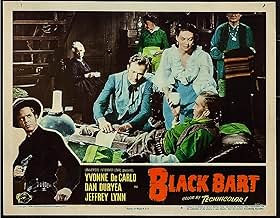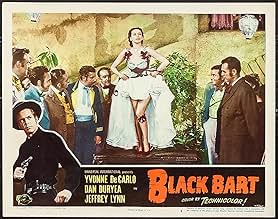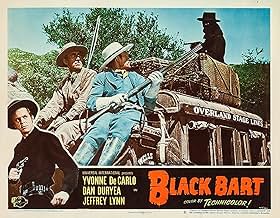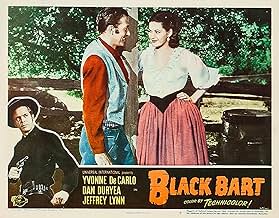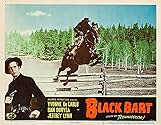Ajouter une intrigue dans votre langueCalifornia stage robber Black Bart meets European dancer Lola Montez.California stage robber Black Bart meets European dancer Lola Montez.California stage robber Black Bart meets European dancer Lola Montez.
- Prix
- 2 victoires au total
Soledad Jiménez
- Teresa
- (as Soledad Jimenez)
Eddy Waller
- Ed Mason
- (as Eddy C. Waller)
Anne O'Neal
- Mrs. Harmon
- (as Anne O'Neil)
Eddie Acuff
- Elkins
- (uncredited)
Earl Audet
- Townsman
- (uncredited)
William Bailey
- Townsman
- (uncredited)
Ray Bennett
- Henry
- (uncredited)
Nina Campana
- Mamacita
- (uncredited)
Avis en vedette
Dan Duryea is Charles Boles, a respectable rancher in Gold Rush California. He's also Black Bart, who holds up stage coaches. Wells Fargo has put a $10,000 reward on him. When his old confederates, Jeffrey Lynn and Percy Kilbride come to town, they take jobs with Wells Fargo. They're also working for themselves when they recognize Duryea and want in. However, Yvonne De Carlo has come to town -- she's Lola Montez -- and she and Duryea fall in love.
It's a highly entertaining and beautifully shot A western from Universal, directed by Henry Hathaway. It's also the ahistorical piffle that infused westerns. Lola Montez (real name: Marie Dolores Eliza Rosanna Gilbert, Countess of Landsfeld) was indeed in the US and performing on stage by about this time, she died in 1861. The real Charles Boles/Black Bart flourished as a stagecoach robber from 1875 through 1883, was captured, spent four years in prison, was released in bad health and disappeared. No one in Hollywood ever let a little thing lack facts get in the way of telling an amusing story.
The highlight is Miss De Carlo's dances as Montez. She had spent half a decade playing uncredited eye-candy roles in Hollywood, before shooting to recognition in SALOME WHEN SHE DANCED. I remember her as Lily Munster, of course, and as one of the cast in Sondheim's FOLLIES; like many a beautiful woman, she had a great sense of humor and comedy about her beauty. She died in 2007, age 84.
It's a highly entertaining and beautifully shot A western from Universal, directed by Henry Hathaway. It's also the ahistorical piffle that infused westerns. Lola Montez (real name: Marie Dolores Eliza Rosanna Gilbert, Countess of Landsfeld) was indeed in the US and performing on stage by about this time, she died in 1861. The real Charles Boles/Black Bart flourished as a stagecoach robber from 1875 through 1883, was captured, spent four years in prison, was released in bad health and disappeared. No one in Hollywood ever let a little thing lack facts get in the way of telling an amusing story.
The highlight is Miss De Carlo's dances as Montez. She had spent half a decade playing uncredited eye-candy roles in Hollywood, before shooting to recognition in SALOME WHEN SHE DANCED. I remember her as Lily Munster, of course, and as one of the cast in Sondheim's FOLLIES; like many a beautiful woman, she had a great sense of humor and comedy about her beauty. She died in 2007, age 84.
Can you be disappointed if you had no expectations in the first place? In this case: yes. This less than a classic western has an above average idea it fails to deliver. The triangle romance between the zorro- like masked villain, the posing- as- a- good- guy villain and the European dancer- and- mistress- to- the- emperor- of- Austria- turned- saloon singer is actually quite original.
The film, however, is not. The standard western imagery and unimaginative cinematography/direction condemns this film into the "forgettable"- category. Still it must be noted that there is no hero in this western: just two outlaws and a corrupt dame. Although they get their due in the "grand" finale, themes like that are not frequent in the westerns of the classic era but associated usually to westerns in the late 60's and 70's.
The film, however, is not. The standard western imagery and unimaginative cinematography/direction condemns this film into the "forgettable"- category. Still it must be noted that there is no hero in this western: just two outlaws and a corrupt dame. Although they get their due in the "grand" finale, themes like that are not frequent in the westerns of the classic era but associated usually to westerns in the late 60's and 70's.
Gorgeous Miss De Carlo often portrayed historic figures:from Sephora to Calamity Jane and from La Castiglione to Lola Montès (spelled "Montez" ,unlike in Europa).Many users probably know Max Ophuls' last opus (1954) which showed a Lola short of the readies,(Martine Carol)who had to work in a circus -under a cynical MC 's Thumb played by Peter Ustinov) Lola was king of Bavaria LudwiG Der Erste 's lover (not to be mistaken for gay Ludwig Der Zweite)and in the movie,you can hear Lola talk about the jewels he bestows on her;"you look at my jewels the way the king used to look at me" ) The story is a bit tongue in cheek and the tale of this masked brigand is not particularly exciting but Lola adds some spice to it.
This Universal B picture is yet another example of Hollywood taking a famous character of the old west and fashioning their own story about him without a bit of reality to it. All that I can say is that Black Bart did go by the real name of Charles Bolles and they did do his crime thing in California in the 19th century. Other than that this film has nothing to do with Black Bart's real story.
Among other things Black Bart was always a gentleman and left a bit of poetic verse at the scene of each robbery. Not a line of poetry comes from Dan Duryea's lips. As Black Bart died in 1888 and Lola Montez died in 1861 it's highly unlikely they ever even met.
Yvonne DeCarlo plays the exotic dancer who had King Ludwig of Bavaria panting for more. But that's all done with, Lola's in America on a tour and she's now in San Francisco. On the way there she meets up with Black Bart when he holds up the stagecoach. Also along are a pair of Duryea's associates from his past, Jeffrey Lynn and Percy Kilbride. They know Duryea even behind the mask and want in on the set up. Lynn also wants in on Lola Montez.
Black Bart despite its gross historical inaccuracies is an interesting and unique film. No happy endings for anyone here as Duryea and Lynn go out like Butch and Sundance. Yvonne DeCarlo is properly fetching as Lola though I think the one who should have played Lola in a better film of her life should have been Greta Garbo.
Among other things Black Bart was always a gentleman and left a bit of poetic verse at the scene of each robbery. Not a line of poetry comes from Dan Duryea's lips. As Black Bart died in 1888 and Lola Montez died in 1861 it's highly unlikely they ever even met.
Yvonne DeCarlo plays the exotic dancer who had King Ludwig of Bavaria panting for more. But that's all done with, Lola's in America on a tour and she's now in San Francisco. On the way there she meets up with Black Bart when he holds up the stagecoach. Also along are a pair of Duryea's associates from his past, Jeffrey Lynn and Percy Kilbride. They know Duryea even behind the mask and want in on the set up. Lynn also wants in on Lola Montez.
Black Bart despite its gross historical inaccuracies is an interesting and unique film. No happy endings for anyone here as Duryea and Lynn go out like Butch and Sundance. Yvonne DeCarlo is properly fetching as Lola though I think the one who should have played Lola in a better film of her life should have been Greta Garbo.
This film manages to be relatively non-formulaic, and even more non-historical, though the real Black Bart was indeed named Charles E. Boles as portrayed. British-born Boles, however, did not conduct his outlaw career as a Zorroesque black-clad horseman, but hiked to all his holdups and wore a long linen duster, with a flour sack over his head. He was also pushing 50 when he started robbing the stage. So much for a romantic image! If the intention was to make Bart/Boles a dashing figure, I think another actor would have been a better choice than Dan Duryea, who after all pretty much built his career on playing creeps. But it's always interesting to see a departure, and the script is more clever than that of the routine horse opera of the day.
As Lola Montez, Yvonne De Carlo makes no effort at a real characterization of the famous Countess (former mistress to Ludwig I of Bavaria), but acts-- well, like Yvonne De Carlo, delivering her lines in her usual flat New World tones. The witty, volatile and multilingual Lola (nee Eliza Gilbert), though Irish by birth, affected a sort of Spanish accent to go with her assumed Sevillian identity. De Carlo's dancing, I fear, bears little resemblance to Lola's, but it's always a pleasure to watch Yvonne in her early roles; this film came only three years after her dazzling debut in 1945's "Salome, Where She Danced", in which she played a quasi Lola Montez, thereby confusing the record considerably.
In reference to this: the real Lola never danced as Salome nor visited Arizona, and the town there called "Salome, Where She Danced" was named in 1904, and for quite another lady. To play Lola or a quasi-Lola, De Carlo does certainly fit the bill visually as a stunning blue-eyed brunette with a memorable figure. As to Lola ever encountering Black Bart-- well, when he began his career as a highway robber in 1875 Lola had been in her grave for fourteen years. So much for romance!
As Lola Montez, Yvonne De Carlo makes no effort at a real characterization of the famous Countess (former mistress to Ludwig I of Bavaria), but acts-- well, like Yvonne De Carlo, delivering her lines in her usual flat New World tones. The witty, volatile and multilingual Lola (nee Eliza Gilbert), though Irish by birth, affected a sort of Spanish accent to go with her assumed Sevillian identity. De Carlo's dancing, I fear, bears little resemblance to Lola's, but it's always a pleasure to watch Yvonne in her early roles; this film came only three years after her dazzling debut in 1945's "Salome, Where She Danced", in which she played a quasi Lola Montez, thereby confusing the record considerably.
In reference to this: the real Lola never danced as Salome nor visited Arizona, and the town there called "Salome, Where She Danced" was named in 1904, and for quite another lady. To play Lola or a quasi-Lola, De Carlo does certainly fit the bill visually as a stunning blue-eyed brunette with a memorable figure. As to Lola ever encountering Black Bart-- well, when he began his career as a highway robber in 1875 Lola had been in her grave for fourteen years. So much for romance!
Le saviez-vous
- AnecdotesFilm debut of Frank Lovejoy.
- GaffesOne of the newspaper columns (c. 1849) mentions automobiles.
- Citations
Clark: I've got an idea that's bigger than anything you've ever heard. It'll take time... and it'll take brains.
Charles E. Boles: I got plenty of time.
- ConnexionsReferenced in Mystery Science Theater 3000: The Phantom Planet (1998)
Meilleurs choix
Connectez-vous pour évaluer et surveiller les recommandations personnalisées
Détails
- Date de sortie
- Pays d’origine
- Langue
- Aussi connu sous le nom de
- Black Bart, Highwayman
- Lieux de tournage
- société de production
- Consultez plus de crédits d'entreprise sur IMDbPro
- Durée
- 1h 20m(80 min)
- Rapport de forme
- 1.37 : 1
Contribuer à cette page
Suggérer une modification ou ajouter du contenu manquant


